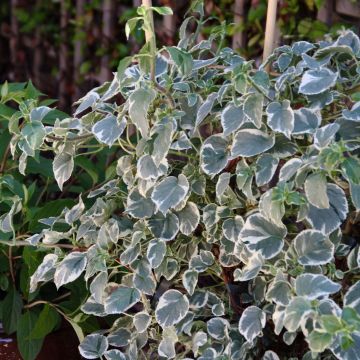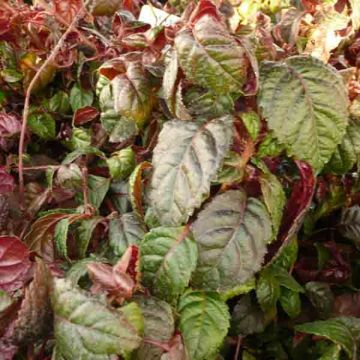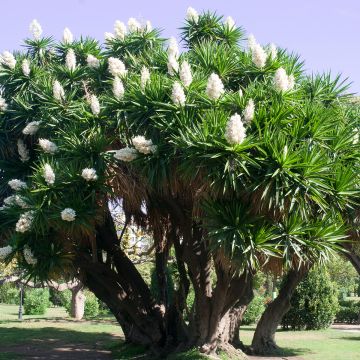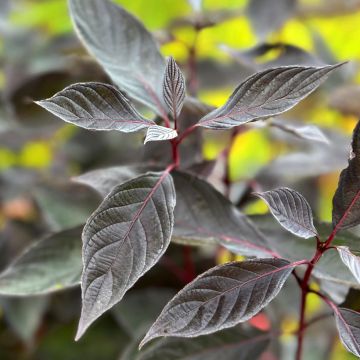

Hydrangea anomala Crug Coral - Hotensia grimpant
Hydrangea anomala Crug Coral- Climbing Hydrangea
Hydrangea anomala sp glabra Crug Coral
Climbing Hydrangea
Received young plant does not match the photo: shorter, less leafy, leaves yellowed.
Anne, 09/09/2023
Special offer!
Receive a €20 voucher for any order over €90 (excluding delivery costs, credit notes, and plastic-free options)!
1- Add your favorite plants to your cart.
2- Once you have reached €90, confirm your order (you can even choose the delivery date!).
3- As soon as your order is shipped, you will receive an email containing your voucher code, valid for 3 months (90 days).
Your voucher is unique and can only be used once, for any order with a minimum value of €20, excluding delivery costs.
Can be combined with other current offers, non-divisible and non-refundable.
Home or relay delivery (depending on size and destination)
Schedule delivery date,
and select date in basket
This plant carries a 6 months recovery warranty
More information
We guarantee the quality of our plants for a full growing cycle, and will replace at our expense any plant that fails to recover under normal climatic and planting conditions.

Would this plant suit my garden?
Set up your Plantfit profile →
Description
Hydrangea anomala 'Crug Coral' is a new variety of climbing hydrangea that will captivate with the unusual rosy colour of its inflorescences. In this plant, the almost-red floral buds bloom in early summer into light flower panicles whose large tender pink florets surround many small cream-coloured flowers. Flowering that is all the more charming as it is enhanced by attractive shiny, bright green leaves and will bloom even in shaded areas of the garden. The long stems of this shrub cling on their own with the help of climbing roots onto bare walls or trees, in the same way as ivy. Although it sometimes takes three years to grow, the climbing hydrangea is a robust plant that will fend for itself once well established.
Originally from Japan and tropical Asia, Hydrangea anomala subsp. glabra is a climbing shrub that is deciduous in winter, belonging to the Hydrangea family. In its native forests, this woody plant grows up to 12 m (39 ft) in height, but it will rarely reach over 5 to 6 m (16 to 19 ft) in cooler climates. It is a very hardy plant (down to at least -20 °C (-4 °F)) that thrives in any deep and rich soil without excess lime that is not overly dry. Its growth is a bit sluggish at the juvenile stage while its roots are anchoring deeply in the soil.
The 'Crug Coral' variety, collected in the mountains of Taiwan around 2016, differs from the classic species by its pink-tinted flowers and slightly smaller leaves. This vigorous liana produces robust and well-ramified woody stems, up to a minimum of 3-4 m (9-13 ft) in height, which form a very interesting structure. These crack with age and their bark peels off in shreds, giving the plant an attractive appearance even in winter. A creeping shrub with a strong covering ability, it is also a bold climber that clings thanks to very efficient climbing roots. Without support, it will not exceed 1.5 m (4 ft 11 in) and will form a large dense bush. The stems bear thick and ovate leaves with a pointed tip, measuring about 6 cm (2.4 in) long by 3 cm (1.2 in) wide, which are finely dentate on the edge, glabrous and a little rough to the touch. Bright green on top and lighter underneath, they turn yellow and sometimes also purplish-red in autumn before falling. This hydrangea usually flowers in June, even in the shade. Its nectariferous flowers, gathered in large umbels sometimes reaching 20 cm (7.9 in) in diameter, resemble flattened parasols. Each is composed of many small fertile cream-coloured flowers with protruding stamens surrounded by a few larger sterile florets, with four pale pink petals. They do not fade but dry slowly on the plant, adopting subtle green and faded red nuances before browning.
This 'Crug Coral' climbing hydrangea, with its attractive pink flowers, is a plant that will bring a lot of charm and a touch of colour to those shaded areas of the garden that are often difficult to landscape. It can be used in the background to cover a north-facing wall or dress up an old dead tree or unsightly construction, but it also proves to be an excellent ground cover, very useful for retaining sloping soils. It pairs well with bushy fuchsias (magellanica), for example, or low-maintenance ground cover plants such as Aegopodium podagraria 'Variegata', perennial Geraniums macrorrhizum or periwinkles. It can also be paired with a shade vine like Parthenocissus henryana and quinquefolia.
Report an error about the product description
Hydrangea anomala Crug Coral- Climbing Hydrangea in pictures




Plant habit
Flowering
Foliage
Botanical data
Hydrangea
anomala sp glabra
Crug Coral
Hydrangeaceae
Climbing Hydrangea
Cultivar or hybrid
Other Climbing Hydrangea
View all →Planting and care
When planting, install Hydrangea 'Crug Coral' in a north- or east-facing exposure, in a deeply worked, well loosened soil that is enriched with compost, without excess lime. If you plant it in an east-facing exposure, remember to water regularly during the first few years and especially in the summer, as the young plant will generally receive little water. A good base fertiliser (horn or dehydrated blood) will aid the recovery of your young plant and nourish it without risk of burning. If your soil tends to be dry, incorporate some topsoil and compost into your garden soil, use a watering can to directly water the bottom of the planting hole (this will moisten the soil deeply for a long time), and provide a watering basin on the surface. You can mulch the root in summer to keep the roots cool, and water regularly if the summer is very dry. After a few years, this plant should be able to manage on its own. If pruning proves necessary to limit its development, it should be done when the leaves fall. Remove faded inflorescences in autumn. Remove poorly placed branches or branches that shoot perpendicularly to the wall's axis or. Ensure that the plant does not damage the roof or gutters.
Planting period
Intended location
Care
-
, onOrder confirmed
Reply from on Promesse de fleurs
Similar products
Haven't found what you were looking for?
Hardiness is the lowest winter temperature a plant can endure without suffering serious damage or even dying. However, hardiness is affected by location (a sheltered area, such as a patio), protection (winter cover) and soil type (hardiness is improved by well-drained soil).

Photo Sharing Terms & Conditions
In order to encourage gardeners to interact and share their experiences, Promesse de fleurs offers various media enabling content to be uploaded onto its Site - in particular via the ‘Photo sharing’ module.
The User agrees to refrain from:
- Posting any content that is illegal, prejudicial, insulting, racist, inciteful to hatred, revisionist, contrary to public decency, that infringes on privacy or on the privacy rights of third parties, in particular the publicity rights of persons and goods, intellectual property rights, or the right to privacy.
- Submitting content on behalf of a third party;
- Impersonate the identity of a third party and/or publish any personal information about a third party;
In general, the User undertakes to refrain from any unethical behaviour.
All Content (in particular text, comments, files, images, photos, videos, creative works, etc.), which may be subject to property or intellectual property rights, image or other private rights, shall remain the property of the User, subject to the limited rights granted by the terms of the licence granted by Promesse de fleurs as stated below. Users are at liberty to publish or not to publish such Content on the Site, notably via the ‘Photo Sharing’ facility, and accept that this Content shall be made public and freely accessible, notably on the Internet.
Users further acknowledge, undertake to have ,and guarantee that they hold all necessary rights and permissions to publish such material on the Site, in particular with regard to the legislation in force pertaining to any privacy, property, intellectual property, image, or contractual rights, or rights of any other nature. By publishing such Content on the Site, Users acknowledge accepting full liability as publishers of the Content within the meaning of the law, and grant Promesse de fleurs, free of charge, an inclusive, worldwide licence for the said Content for the entire duration of its publication, including all reproduction, representation, up/downloading, displaying, performing, transmission, and storage rights.
Users also grant permission for their name to be linked to the Content and accept that this link may not always be made available.
By engaging in posting material, Users consent to their Content becoming automatically accessible on the Internet, in particular on other sites and/or blogs and/or web pages of the Promesse de fleurs site, including in particular social pages and the Promesse de fleurs catalogue.
Users may secure the removal of entrusted content free of charge by issuing a simple request via our contact form.
The flowering period indicated on our website applies to countries and regions located in USDA zone 8 (France, the United Kingdom, Ireland, the Netherlands, etc.)
It will vary according to where you live:
- In zones 9 to 10 (Italy, Spain, Greece, etc.), flowering will occur about 2 to 4 weeks earlier.
- In zones 6 to 7 (Germany, Poland, Slovenia, and lower mountainous regions), flowering will be delayed by 2 to 3 weeks.
- In zone 5 (Central Europe, Scandinavia), blooming will be delayed by 3 to 5 weeks.
In temperate climates, pruning of spring-flowering shrubs (forsythia, spireas, etc.) should be done just after flowering.
Pruning of summer-flowering shrubs (Indian Lilac, Perovskia, etc.) can be done in winter or spring.
In cold regions as well as with frost-sensitive plants, avoid pruning too early when severe frosts may still occur.
The planting period indicated on our website applies to countries and regions located in USDA zone 8 (France, United Kingdom, Ireland, Netherlands).
It will vary according to where you live:
- In Mediterranean zones (Marseille, Madrid, Milan, etc.), autumn and winter are the best planting periods.
- In continental zones (Strasbourg, Munich, Vienna, etc.), delay planting by 2 to 3 weeks in spring and bring it forward by 2 to 4 weeks in autumn.
- In mountainous regions (the Alps, Pyrenees, Carpathians, etc.), it is best to plant in late spring (May-June) or late summer (August-September).
The harvesting period indicated on our website applies to countries and regions in USDA zone 8 (France, England, Ireland, the Netherlands).
In colder areas (Scandinavia, Poland, Austria...) fruit and vegetable harvests are likely to be delayed by 3-4 weeks.
In warmer areas (Italy, Spain, Greece, etc.), harvesting will probably take place earlier, depending on weather conditions.
The sowing periods indicated on our website apply to countries and regions within USDA Zone 8 (France, UK, Ireland, Netherlands).
In colder areas (Scandinavia, Poland, Austria...), delay any outdoor sowing by 3-4 weeks, or sow under glass.
In warmer climes (Italy, Spain, Greece, etc.), bring outdoor sowing forward by a few weeks.


















































